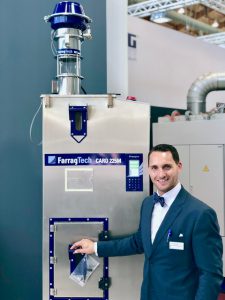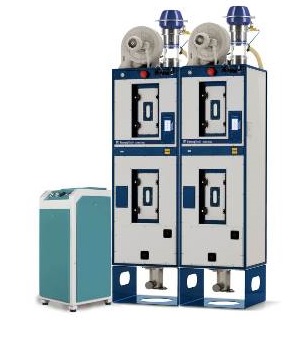 For most companies until the beginning of the 1990s, resin drying carried out with adsorption driers to dehumidify plastic material was still the tool of choice. However, this procedure came along, among other things, with high acquisition, maintenance and energy costs. Moreover, over time the result suffered from the continuously decreasing performance of the integrated molecular sieve.
For most companies until the beginning of the 1990s, resin drying carried out with adsorption driers to dehumidify plastic material was still the tool of choice. However, this procedure came along, among other things, with high acquisition, maintenance and energy costs. Moreover, over time the result suffered from the continuously decreasing performance of the integrated molecular sieve.
With his invention of the Economic Resin Dryer (ERD) in 1991, Rainer Farrag revolutionized the resin drying process: With the first-time use of compressed air during drying, it was then possible to ensure consistent product quality at low energy consumption. Over the years, the proven ERD technology has been further developed and is being used to this day – however under the name of CARD (Compressed Air Resin Dryer). The dryer variants of this series can, among other things, be combined with systems for condensation water protection and for internal mold cooling. This way, they make entire processes of plastic processing more efficient. The Farrag Tech GmbH, developers of the sustainable dryer technology, will exhibit at the K fair trade in Düsseldorf in the middle of October.
“Within the bounds of the extrusion blow molding process, it was standard for a long time to vent the dry blower air at the end of each cycle,” reports Rainer Farrag, founder of the Austrian FarragTech GmbH. “As a result, a lot of unused air – and thus also energy – went lost, what I found was a pity. So in 1991, the idea struck me to use the air further for resin drying.” Without being aware of that, the entrepreneur set a milestone in the history of plastic processing. Because the idea of drying hygroscopic resins by adding compressed air from an upstream process made it possible to dehumidify material almost without additional energy and without moving parts. This way, the procedure quickly offered a cost-effective and reliable alternative to the adsorption drying method that was common at the time. But the effected paradigm shift was also due to the fact that the new compressed air dryer – contrary to the adsorption dryer – utilized essential saving potentials. So the use of a molecular sieve within the bounds of the traditional dehumidification method was mostly accompanied by high costs for regular maintenance, repairs and new acquisitions. Since the Economic Resin Dryer (ERD), so the name of the Farrag innovation, dispensed with chemical or mechanical stress, such negative consequences could be avoided. “Especially the consistent result was and still is a central quality feature of the compressed air dryer,” explains Farrag.
 Today’s CARD series is even more energy-efficient
Today’s CARD series is even more energy-efficient
Even if the basic technology of the development has remained unaffected to the present day, some improvements of the system were made over the years which today are known under the name of CARD. So better process integration and modern controls such as the SLEEP mode or the reduction of the amount of air after reaching a particular temperature in the upper range of the drying hopper ensure an additional reduction of energy consumption within the entire process; the heat recovery from the air compressor has meanwhile led to resin drying which can mostly dispense with additionally supplied energy.
Nowadays, the CARD is not only used for pure resin drying, but also in combination with other systems. The idea for this came Farrag at the end of the 1990s. “At that time, with a US-American customer from Wisconsin, I used the necessary compressed air from the extrusion blow molding process for the internal cooling of a gas can,” reports the company founder. “I used the purge air occurring during this process again for drying the raw material, and the dry exhaust air from the container was subsequently fed into the isolated tool area.” That way, within a single process, Farrag managed to combine the dehumidification of the resin with the internal cooling of the product, avoiding material stress due to the additional condensation water of the supplied exhaust air. Subsequently, the production could be increased by 35 per cent at increased product quality and lower manufacturing costs.
Such results also did not remain concealed to the industry; the compressed air technology within the framework of resin drying is enjoying ever more growing popularity. “It has to be assumed that resin drying using compressed air will become the standard in the plastics industry in the years to come,” Farrag finally says. “We as inventors want to drive this development forward with further innovations.”
At the K trade fair 2019, the bulk materials dryers CARD E/S, CARD M and CARD L/XL as well as the internal cooling units Blow Molding Booster and Blow Air Chiller will be presented.
Home page image: Even if the basic technology of the development has remained unaffected to the present day, some improvements of the system were made over the years.
Source: FarragTech GmbH












